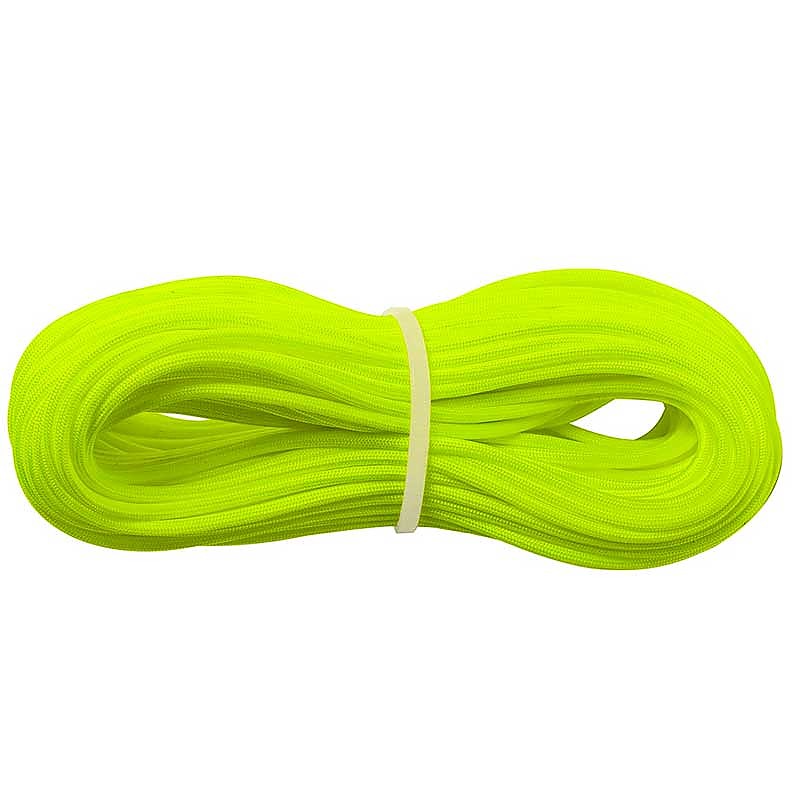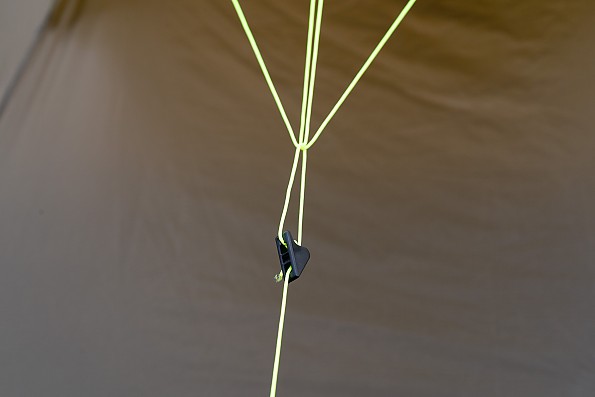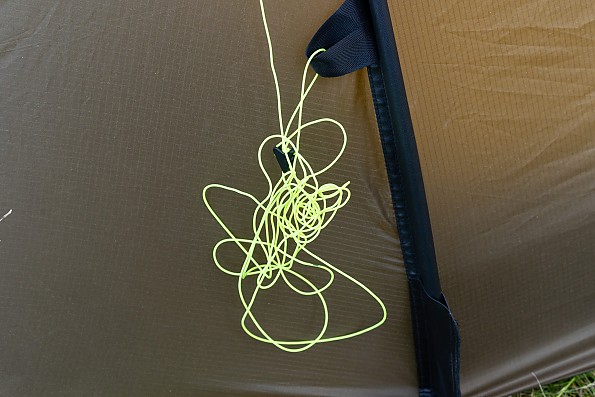Zpacks Z-Line Dyneema Cord 1.2 mm

Strong (over 200 lbs / 90 kg reported) and extremely brightly-colored 1.2-mm cord, perfect for making ultralight guylines and similar applications.
Pros
- Extremely high visibility in all conditions
- Very strong for such a thin cord
- Completely tangle-proof due to notable stiffness
- Reduces weight and packed size in shelters with long guylines
Cons
- Not braided, the outer sheath may slip in some cases
Immediately after purchasing my Hilleberg Kaitum 3 tent I saw that it contains around 25 meters of strong and overly thick 3-mm cord divided into 8 dual guylines. Normally I use the guylines on my tents very rarely, so after some time I decided to reduce the bulkiness and weight of my tent by replacing the guylines to more lightweight ones, preferably with better visibility at night.
Initially I tried the cheap green Chinese 2.5 mm guylines with reflective thread. But I didn’t like their quality (the sheath had some fraying tendency), and what’s worse, these guylines were next to invisible during the daytime due to their darkish green color! In the end I was less than impressed with resulting weight and bulkiness savings.
Small wonder that soon I decided to purchase the 1.2 mm Z-Line Dyneema Cord by Zpacks.
This cord is made of Dyneema fiber (ultra-high-molecular-weight polyethylene) core with polyester sheath. It comes in bright yellow and black colors, 50 ft (15.2 m) per piece. I wanted the brightest available cord, so I chose the yellow color, and also I opted for 1.2 mm thickness for reducing the bulkiness and weight as much as possible. The reported breaking strength of this cord exceeds 200 lbs (90 kg).
After more than a year of using this cord in my guylines (plus other similar applications) I’m really happy with my choice. The cord is extremely bright and visible, even on the photos it appears much thicker than it really is. In day and night, it’s next to impossible to overlook this cord while passing by, so I really love its color! In the meantime, lack of reflective thread makes it less visible at night from large distance, which increases stealth.
I've tangled it by myself, and it took a mere second to unwrap this 2-meter guyline
Despite the tiny diameter, this cord is stiff, so it has zero tendency to tangling. If I make a knot on it, I can easily untie it when necessary. The stated strength in more than enough for my needs, as I weigh 1.5 times less than the cord strength.
I use my guylines quite rarely, after a year there is no wear or fraying visible anywhere on the cord sheath. This cord is not interwoven like that in Hilleberg tents, so in some cases the core may slip relative to the sheath. Careful flaming to make a tight bond between core and sheath is advised after trimming this cord.
This cord works excellent with Clamcleat Mini Line-Lok CL266 line runners (aka 2 mm Hilleberg Guy Line Runners), you just need to make a larger dual knot when attaching the cord to a guyline. The grip is very strong and secure. Don’t use generic Chinese line runners with this cord, as they’re made for 2-3 mm thick line and may slip on this 1.2 mm cord.
In case of my tent, considering the total combined guyline length of around 25 meters, the volume savings in packed tent were about 0.5 liters. Of course replacing the Hilleberg guylines to this cord was my caprice, and most people will not even think about it. By the way, I use the pieces of this cord as zipper pullers in the tent, and the bright color comes very handy at night.
 In low light conditions this cord is extremely visible
In low light conditions this cord is extremely visible
The bottom line: this is an excellent choice for those considering strong and super-visible ultralight cord for their tents, shelters, and other applications (such as tying the loops to stakes or zipper pullers) .
Source: bought it new
Price Paid: 30 USD for 100 ft
Very light weight makes this a good addition to one's kit, but it cannot replace conventional cord/rope in certain applications.
Pros
- Very light
Cons
- Small diameter make use as a haul rope very difficult
- Must use nonconventional knots to prevent slippage or untying of knots while under loads.
The UL qualities of Dyneema cord and similar tech fiber cords are amazing. I like Dyneema cord for its weight/strength ratio, but it has certain limitations and considerations worth noting. As Vladimir commented, the cord is rather stiff, which is why it is easy to untangle—good—and untie—not so good. In fact knots in dyneema cord may have the tendency to untie themselves while under tension loads.
The good news is there alternatives to the sundry hitch and cinch knots learned in scouts that are more effective. These knots are discussed on the web where Dyneema cord is a topic. Likewise there are tensioning devices made for this cord that also work well.
The biggest limitation I found using Dyneema cord is it doesn’t perform well as a haul rope, for example, hoisting a bear hang. Even if you first rig a pulley or carabineer up in the tree as a hoist point, the small diameter of the cord digging into your hand makes it almost impossible to loft more than ten pounds into the air. Thus my bear hang rope is now a length of ¼” kernmantle nylon rope for the portion that runs through my carabineer hoist point, while the portion that leads out from there to my food is the Dyneema cord. The static line securing the carabineer is also Dyneema. Incorporating the Dyneema cord thusly cut the weight of my hoist kit by two thirds, because I generally hang my stuff between trees, which requires a longer length of cordage.
Reference the following link for an explanation of this hang method: https://www.trailspace.com/forums/beginners/topics/73615.html#74519
Source: bought it new
Price Paid: ~$13 US
Your Review
Where to Buy
You May Like
Specs
| Breaking Strength |
over 200 lbs |
| Weight |
.033 oz per yard / 1 g per meter |
| Weight per 50ft |
.55 oz /16 g |






